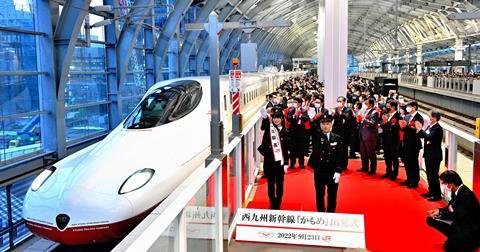
JAPAN: JR Kyushu has started revenue service on the Nishi-Kyushu Shinkansen between Takeo Onsen and Nagasaki in the far southwest of the country.
This is the first section of high speed line to open since the 148 km of the Hokkaido Shinkansen between Shin-Aomori and Shin-Hakodate-Hokuto which opened in March 2016 and the Nagano – Kanazawa section of the Hokuriku Shinkansen completed in March 2015.
At just 66 km the Nishi-Kyushu Shinkansen is one of the shortest stretches of high speed line in the world, and at present it is completely isolated from the rest of Japan’s 1 435 mm gauge network.
The route features 31 tunnels with a combined length of more than 40 km. Another 21 km runs on bridges and viaducts, leaving just 5∙3 km at grade.

The main opening ceremony took place early in the morning of September 23 at Nagasaki station, where there was a ribbon-cutting on the platform prior to the departure of the 06.17 service to Takeo Onsen. The train was flagged off by local pop star Neru Ngahama, who had been appointed station manager for the day.
JR Kyushu’s high speed services on the route have been branded Kamome (seagull), and are operated by a fleet of four six-car Series N700S-8000 trains with capacity for 396 passengers. The trains were built at Hitachi’s Kasado works and delivered by sea to a new depot at Omura in January.
The trains are based on the N700S design used on Tokaido and Sanyo Shinkansen services since 2020.

Relay bridges the gap
The 54 km gap between Takeo Onsen and Shin-Tosu on the Kyushu Shinkansen, which provides a through high speed corridor to Tokyo, is being filled by 1 067 mm gauge so-called ‘relay’ services. Journey time from Hakata to Nagasaki including the change of trains is around 1 h 30 min, a reduction of 30 min compared to the former Kamome Limited Express services using the conventional route.
At Takeo Onsen just 3 min is timetabled for passengers to change trains, but connections at both interchanges are made across a shared platform.

At present JR Kyushi is providing 22 Kamome trips per day in each direction between Takeo Onsen and Nagasaki, most calling at the three intermediate stations, but some omitting Ureshino Onsen and Shin Omura. The Kamome Relay service over the 82 km between Takeo Onsen and Hakata takes around 1 h, with some slightly longer journey times caused by path availability.
The new line is expected to remain isolated from the rest of the high speed network for the foreseeable future, not least because the route cost around 20% more to complete than was envisaged when the project was approved. The eventual outturn cost was ¥620bn.
Both existing 1 067 mm gauge lines between Takeo Onsen and Nagasaki, via Hizen-Kashima and via Huis Ten Bosch, have for now retained their local passenger services.
Local authorities are hopeful that the new line could spur a revival in tourism in the region.


















